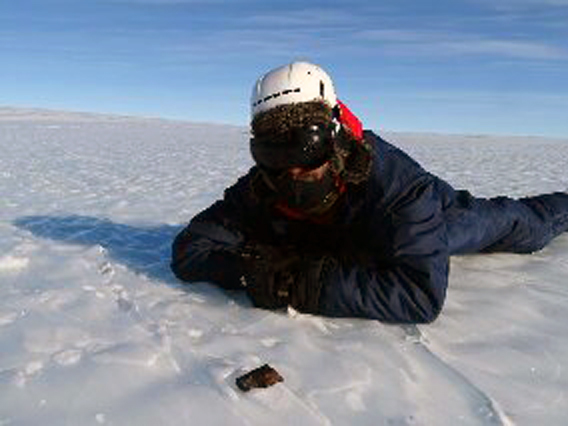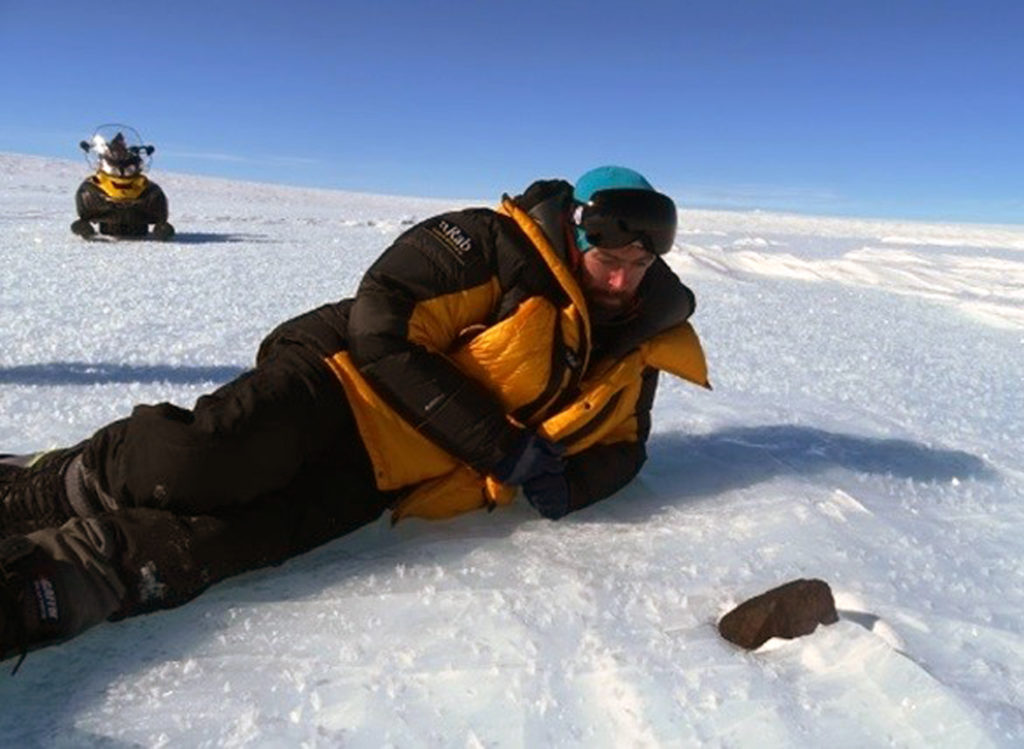69 ‘surface meteorites’ but no subsurface specimens found – Panel sledge detector system has broken – UK meteorite search in Antarctica 2019/2020 – Lost meteorites of Antarctica Project
Last update: 4 January 2024
The 2019/20 main field trip of the project Lost Meteorites of Antarctica to recover subsurface iron meteorites on some blue icefields in Antarctica did not end as planned. Four members of the University of Manchester’s UK Polar Meteorite Exploration and Research Team (Geoff Evatt, Wouter Van Verre, Katherine (Katie) Joy und Romain Tartese) reached the British Antarctic Survey (BAS) base Rothera on 27 November and prepared for their six-week field search together with their guide Taff Raymond. They wanted to search and scan 15 to 20 square kilometres with two snowmobile-drawn five panel (2 × 1.1m each) pulse induction metal detector arrays and hoped to find four to five subsurface iron meteorites and maybe up to 80 stony specimens on the surface. The team searched the newly named Outer Recovery Ice Field which is about 2000 km away from Rothera Station and had already been visited by Katherine Joy and field guide Julie Baum during their reconnaissance mission in January 2019 when they searched several ice fields in the Recovery Glacier region (81°10′S, 28°00′W), on the southern side of the Shackleton Range as well as the northern areas of Argentina Range (82°18’27.2″S, 41°53’30.3″W). The reconnaissance mission resulted in about 38 surface meteorite finds which are currently in classification. The Lost Meteorites of Antarctica Project tries to confirm the theory of a hidden layer of subsurface Antarctic meteorites, published by Evatt et al in February 2016.
On 5 December Geoff Evatt, Romain Tartese and Rob Taylor left Rothera and flew to Outer Recovery Ice Field with an AZ Twin Otter. Wouter Van Verre and Katherine (Katie) Joy followed a few days later. On 17 December the first eight surface meteorites, including five ‘relatively sizeable’ ones were found within a couple of hours by Evatt, Van Verre and Taylor on the blue ice fields in the middle latitudes of the Outer Recovery area, the location where the detector arrays were deployed ( 81°29’49.0″S 17°57’08.3″W ). By 20 December all team members had reached the search site. Snowfall which covered the blue ice fields facilitated scanning for subsurface meteorites but made it temporarily more difficult to see specimens on the surface. By 8 January 2020 when the last panel sledge detector system broke and thus making the search for subsurface meteorites impossible no subsurface iron meteorites had unfortunately been found after having systematically scanned an area of about 0.74 km². 69 surface meteorites could be recovered though. On 9 January Geoff Evatt, Wouter Van Verre, and Romain Tartese left the field and flew back to Rothera, Katherine (Katie) Joy and Taff Raymond followed on 18 January 2020. The two main search field areas have been approved as the Outer Recovery Icefields in Dronning Maud Land by the Norwegian Polar Institute and Hutchison Icefield in Coats Land (British Antarctic Territory ) by the UK Antarctic Place-names Committee. The Meteoritical Society has approved the names as dense meteorite collection areas. Meteorites will either be called OUT (Outer Recovery Icefields) or HUT (Hutchison Icefield).
Found specimens
Outer Recovery Icefields 19131 (LL6, 941 g, 81°34.74600’S, 17°28.00900’W)
A list of all Outer Recovery Icefields finds can be found HERE
A list of all Hutchison Icefield finds can be found HERE

A systematic panel array search for subsurface iron meteorites in the Outer Recovery Icefields was done in the yellow area around location 81°29’49.0″S 17°57’08.3″W. The skidoo search for surface meteorites was performed primarily in the red areas. 107 surface specimens have been found on four icefields during the 2018/19 and 2019/20 search campaigns.

The two field sites (black boxes) in a Landsat Image. Image: Katherine Joy

Outer Recovery Icefield with four blue ice fields in a Landsat Image (1:250000) with a Sentinel 2 image overlay. Halliday Nunatak (81°24’32.97″S, 18° 1’59.88″W) was named after Canadian astronomer Dr Ian Halliday (1928-2018). Image: Katherine Joy

The map (Sentinel 2 image) shows the Hutchison Icefield area. Hutchison Icefield (81°30′ 30″S, 26°10’W) was named after British meteorite scientist Dr Robert Hutchison (1938-2007), Curator of Meteorites at the NHM, London. The Hutchison Icefield area contains Turner Nunatak (Hutchison Icefield) and Pillinger Nunatak (Hutchison Icefield). Turner Nunatak (81°27′ 50.42″S, 26°24’48.88″W) was named after Professor Grenville Turner FRS (b. 1936), Emeritus Professor at the University of Manchester. Pillinger Nunatak (81°34’40″S, 26°24’15″W) was named after Professor Colin Pillinger FRS (1943-2014). Original image: Dr Adrian Fox

One of the first surface meteorite finds. Photo: Geoff Evatt

One of the first found surface meteorites. Photo: Wouter van Verre

Guide Rob Taylor with a found meteorite. Photo: Geoff Evatt

Geoff Evatt next to a found specimen. Photo: Romain Tartese

The team members rejoice in a small meteorite find. Photo: Katherine Joy

A small flight orientated meteorite in situ. Photo: Katherine Joy

Katherine Joy next to a larger specimen.

A larger meteorite in situ. Photo: Katherine Joy

Another find. Photo: Geoff Evatt

A small surface find. Photo: Geoff Evatt

Geoff Evatt next to a small surface find. Photo: Katherine Joy

A larger specimen. Photo: Katherine Joy

A meteorite embedded in the blue ice, found on 16 January 2020. Photo: Katherine Joy

The roll-over lipped trailing side of the oriented carbonaceous chondrite Outer Recovery Icefields 19139 (CM, 65.439 g) in situ, found at location 81°33.62100’S, 17°31.91100’W on the Outer Recovery 4 (south) Icefields on 16 January 2020. Photo: Katherine Joy

Taff Raymond next to Outer Recovery Icefields 19139 (CM, 65.439 g) found on 16 January 2020. Photo: Katherine Joy

Outer Recovery Icefields 19139 (CM, 65.439 g) in situ on 16 January 2020. Photo: Jane MacArthur

Outer Recovery Icefields 19139 (CM, 65.439 g). Photo: Jane MacArthur

Another interesting find. Photo: Katherine Joy
Dr Romain Tartese and Dr Katherine Joy towing the meteorite metal-detector panel equipment at the Outer Recovery Icefields. Video: Dr Katherine Joy
Dr Katherine Joy (orange top) and Dr Geoff Evatt (blue overalls) searching for meteorites with a metal detector after a reading had been made with the metal detection drag panels. Video: Dr Katherine Joy
Dr Katherine Joy (below the camera view), Dr Romain Tartese (on the middle track) and field guide Taff Raymond (in the distance on the right) systematically searching the Outer Recovery Icefields. Video: Dr Katherine Joy
3D-models of some of the found meteorite. shown sample 1: ~2450 g, sample 2: ~30 g, sample 3: ~14 g. Video: T. A. Harvey
See also UK meteorite search reconnaissance mission in Antarctica 2018/2019 – 36 meteorites found (19 January 2019)
A potential hidden layer of meteorites below the ice surface of Antarctica
G. W. Evatt, M. J. Coughlan, K. H. Joy, A. R. D. Smedley, P. J. Connolly, I. D. Abrahams
Nature Communications 7,
Article number: 10679, published 16 February 2016
The Lost Meteorites of Antarctica Project: A New UK-Led Antarctic Meteorite Recovery Programme
K. H. Joy, G. E. Evatt, A. R. D. Smedley, I. D. Abrahams, A. Peyton, L. A. Marsh, J. Wilson, J. Davidson, W. van Verre, M. Rose, L. Gerrish, T. Harvey
50th Lunar and Planetary Science Conference (2019), Abstract #1018
None-destructive determination of the physical properties of Antarctic meteorites
T. A. Harvey, J. L. MacArthur , K. H. Joy, R. H. Jones
52nd Lunar and Planetary Science Conference 2021 (LPI Contrib. No. 2548)
interactive conference poster
The Lost Meteorites of Antarctica
Online talk by Dr. Katherine Joy on 19 June 2020
































